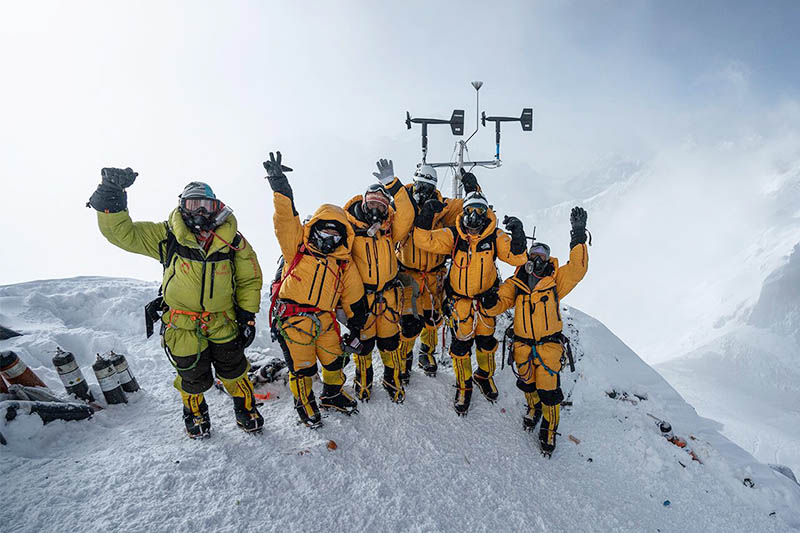NatGeo announces installation of world's highest operating weather stations on Mt Everest
KATHMANDU: The National Geographic Society today announced the successful installation of the world's highest operating weather stations on Mt Everest to provide researchers, climbers, and the public with near real-time information about mountain conditions.
“The multidisciplinary team Installed the world's two highest operating automated weather stations at Balcony area (8,430 m) and South Col (7,945 m), as well as three other weather stations on Mt Everest,” Fae Jencks, Director, Marketing and Communications at the National Geographic Society, said in a statement.
The other stations were placed at Phortse (3,810 m), Everest Base Camp (5,315 m) and Camp II (6,464 m), it said, adding that each weather station will record data on temperature, relative humidity, barometric pressure, wind speed, and wind direction.
Data from the weather stations and other new research conducted as part of National Geographic and Rolex’s Perpetual Planet Extreme Expedition to Mt Everest will help communities respond to climate risks that threaten the lives and livelihoods of the more than one billion people in the region.
The successful installation of the world's highest operating weather stations aims to break new ground in our monitoring and understanding of climate change as the stations will help continuously monitor the upper reaches of the atmosphere, which is critical to tracking and predicting weather patterns around the globe, the statement added.
“The Balcony weather station is the first weather station installed at an elevation above 8,000 meters, meaning it will also be the first to sample the stratosphere as natural variations in the atmospheric boundaries change over time.”
From April to June 2019, an international team of scientists, climbers and storytellers, led by the NatGeo Society and Tribhuvan University and supported in partnership with Rolex, conducted a scientific expedition to Mt Everest, believed to be the most comprehensive single scientific expedition to the mountain in history, it claimed.
According to the statement, the multidisciplinary team also collected the highest-ever ice core sample (at 8,020 meters), conducted comprehensive biodiversity surveys at multiple elevations, completed the highest-elevation helicopter-based lidar scan, expanded the elevation records for high-dwelling species and documented the history of the mountain’s glaciers.
As studies have shown that the glaciers of the Hindu Kush–Himalaya, where Mt Everest is located, are rapidly disappearing due to increasing global temperatures, the extreme conditions of high-elevation mountain ranges have made studying the true impacts of climate and environmental changes nearly impossible.
“As a result, there are critical knowledge gaps about the history of these glaciers and about future impacts that their disappearance would have on the lives and livelihoods of the more than one billion people in the region who depend on the reliable flow of water these glaciers provide.”
Jonathan Baillie, executive vice president and chief scientist at the National Geographic Society said that climate change was one of the biggest challenges facing humanity and there was still much to learn about how it’s already altered the world, from the deepest parts of the ocean to its tallest mountains.
“By harnessing our 131-year history of exploration and venturing into some of the most extreme environments on the planet, we will fill critical data gaps on the world’s life support systems and drive solutions to assure that they can continue to fuel our future.”
With team members from eight countries, including 17 Nepali researchers, the expedition team conducted trailblazing research in five areas of science that are critical to understanding environmental changes and their impacts: biology, glaciology, meteorology, geology and mapping.
Extreme Expeditions in these environments will support new decision-making tools, called Perpetual Planet Extreme Indices, which will provide real-time and historical data on the factors that contribute to the health of these ecosystems, according to the statement.
THE INITIAL OUTCOMES:
- Installation of the world's two highest operating automated weather stations (8,430 meters and 7,945 meters), as well as three other weather stations on Mount Everest
- Collection of the world's highest ice core (8,020 meters) and other ice cores from lower elevations
- Completion of the highest-elevation helicopter-based lidar scan
- Completion of the most detailed lidar scans and photogrammetric imaging of the Everest Base Camp area and the entire Khumbu Glacier ever completed
- Collection of water samples from seven glacial lakes for biodiversity assessment
- Collection of glacial lake sediment cores from Gokyo Valley lakes
- Surveys of biodiversity and wildlife in multiple high-elevation environments
- Installation of four biodiversity monitoring stations in the high Himalaya






